
Concept explainers
a.
To verify defence department outlays.
a.
Answer to Problem 58E
Explanation of Solution
Given information:
The table shows the total national outlays
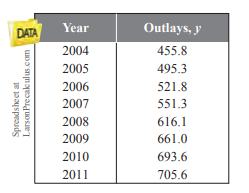
Find the least squares regression line
Calculation:
Consider the given system of equations,
Multiply equation
Substitute
Hence the result is
Now the least square regression formula is
b.
To verify defence department outlays.
b.
Answer to Problem 58E
The results are same as part
Explanation of Solution
Given information:
The table shows the total national outlays
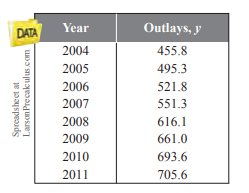
Use the regression feature of a graphing utility to confirm the result of part
Calculation:
Now the least square regression formula is
Now use calculator to verify the part

Hence, the results are same as part
c.
To verify defence department outlays.
c.
Answer to Problem 58E
Explanation of Solution
Given information:
The table shows the total national outlays
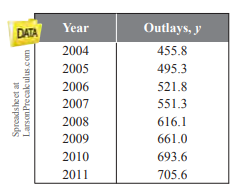
Use the linear model to create a table of estimated values of Compare the estimated values with the actual data.
Calculation:
d.
To verify defence department outlays.
d.
Answer to Problem 58E
Explanation of Solution
Given information:
The table shows the total national outlays
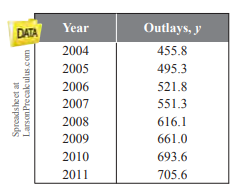
Use the linear model to estimate the total national outlay for
Calculation:
Let
Put
Hence the total national outlay in
e.
To verify defence department outlays.
e.
Answer to Problem 58E
(Calculated value)
Explanation of Solution
Given information:
The table shows the total national outlays

Use the Internet, your school’s library, or some other reference source to find the total national outlay for
Calculation:
In
But the calculates value is
Hence, (calculated value)
f.
To verify defence department outlays.
f.
Answer to Problem 58E
This model is not valid for long-term predictions of total national outlays.
Explanation of Solution
Given information:
The table shows the total national outlays
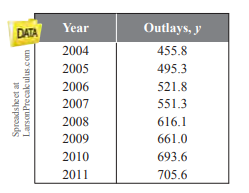
Is the linear model valid for long-term predictions of total national outlays? Explain.
Calculation:
This model is not valid for long-term predictions of total national outlays.
Chapter 7 Solutions
EBK PRECALCULUS W/LIMITS
- In each of Problems 1 through 4, draw a direction field for the given differential equation. Based on the direction field, determine the behavior of y as t → ∞. If this behavior depends on the initial value of y at t = 0, describe the dependency.1. y′ = 3 − 2yarrow_forwardB 2- The figure gives four points and some corresponding rays in the xy-plane. Which of the following is true? A B Angle COB is in standard position with initial ray OB and terminal ray OC. Angle COB is in standard position with initial ray OC and terminal ray OB. C Angle DOB is in standard position with initial ray OB and terminal ray OD. D Angle DOB is in standard position with initial ray OD and terminal ray OB.arrow_forwardtemperature in degrees Fahrenheit, n hours since midnight. 5. The temperature was recorded at several times during the day. Function T gives the Here is a graph for this function. To 29uis a. Describe the overall trend of temperature throughout the day. temperature (Fahrenheit) 40 50 50 60 60 70 5 10 15 20 25 time of day b. Based on the graph, did the temperature change more quickly between 10:00 a.m. and noon, or between 8:00 p.m. and 10:00 p.m.? Explain how you know. (From Unit 4, Lesson 7.) 6. Explain why this graph does not represent a function. (From Unit 4, Lesson 8.)arrow_forward
- Find the area of the shaded region. (a) 5- y 3 2- (1,4) (5,0) 1 3 4 5 6 (b) 3 y 2 Decide whether the problem can be solved using precalculus, or whether calculus is required. If the problem can be solved using precalculus, solve it. If the problem seems to require calculus, use a graphical or numerical approach to estimate the solution. STEP 1: Consider the figure in part (a). Since this region is simply a triangle, you may use precalculus methods to solve this part of the problem. First determine the height of the triangle and the length of the triangle's base. height 4 units units base 5 STEP 2: Compute the area of the triangle by employing a formula from precalculus, thus finding the area of the shaded region in part (a). 10 square units STEP 3: Consider the figure in part (b). Since this region is defined by a complicated curve, the problem seems to require calculus. Find an approximation of the shaded region by using a graphical approach. (Hint: Treat the shaded regi as…arrow_forwardSolve this differential equation: dy 0.05y(900 - y) dt y(0) = 2 y(t) =arrow_forwardSuppose that you are holding your toy submarine under the water. You release it and it begins to ascend. The graph models the depth of the submarine as a function of time. What is the domain and range of the function in the graph? 1- t (time) 1 2 4/5 6 7 8 -2 -3 456700 -4 -5 -6 -7 d (depth) -8 D: 00 t≤ R:arrow_forward0 5 -1 2 1 N = 1 to x = 3 Based on the graph above, estimate to one decimal place the average rate of change from x =arrow_forwardComplete the description of the piecewise function graphed below. Use interval notation to indicate the intervals. -7 -6 -5 -4 30 6 5 4 3 0 2 1 -1 5 6 + -2 -3 -5 456 -6 - { 1 if x Є f(x) = { 1 if x Є { 3 if x Єarrow_forwardComplete the description of the piecewise function graphed below. 6 5 -7-6-5-4-3-2-1 2 3 5 6 -1 -2 -3 -4 -5 { f(x) = { { -6 if -6x-2 if -2< x <1 if 1 < x <6arrow_forwardLet F = V where (x, y, z) x2 1 + sin² 2 +z2 and let A be the line integral of F along the curve x = tcost, y = t sint, z=t, starting on the plane z = 6.14 and ending on the plane z = 4.30. Then sin(3A) is -0.598 -0.649 0.767 0.278 0.502 0.010 -0.548 0.960arrow_forwardLet C be the intersection of the cylinder x² + y² = 2.95 with the plane z = 1.13x, with the clockwise orientation, as viewed from above. Then the value of cos (₤23 COS 2 y dx xdy+3 z dzis 3 z dz) is 0.131 -0.108 -0.891 -0.663 -0.428 0.561 -0.332 -0.387arrow_forward2 x² + 47 The partial fraction decomposition of f(x) g(x) can be written in the form of + x3 + 4x2 2 C I where f(x) = g(x) h(x) = h(x) + x +4arrow_forwardarrow_back_iosSEE MORE QUESTIONSarrow_forward_ios
 Calculus: Early TranscendentalsCalculusISBN:9781285741550Author:James StewartPublisher:Cengage Learning
Calculus: Early TranscendentalsCalculusISBN:9781285741550Author:James StewartPublisher:Cengage Learning Thomas' Calculus (14th Edition)CalculusISBN:9780134438986Author:Joel R. Hass, Christopher E. Heil, Maurice D. WeirPublisher:PEARSON
Thomas' Calculus (14th Edition)CalculusISBN:9780134438986Author:Joel R. Hass, Christopher E. Heil, Maurice D. WeirPublisher:PEARSON Calculus: Early Transcendentals (3rd Edition)CalculusISBN:9780134763644Author:William L. Briggs, Lyle Cochran, Bernard Gillett, Eric SchulzPublisher:PEARSON
Calculus: Early Transcendentals (3rd Edition)CalculusISBN:9780134763644Author:William L. Briggs, Lyle Cochran, Bernard Gillett, Eric SchulzPublisher:PEARSON Calculus: Early TranscendentalsCalculusISBN:9781319050740Author:Jon Rogawski, Colin Adams, Robert FranzosaPublisher:W. H. Freeman
Calculus: Early TranscendentalsCalculusISBN:9781319050740Author:Jon Rogawski, Colin Adams, Robert FranzosaPublisher:W. H. Freeman
 Calculus: Early Transcendental FunctionsCalculusISBN:9781337552516Author:Ron Larson, Bruce H. EdwardsPublisher:Cengage Learning
Calculus: Early Transcendental FunctionsCalculusISBN:9781337552516Author:Ron Larson, Bruce H. EdwardsPublisher:Cengage Learning





